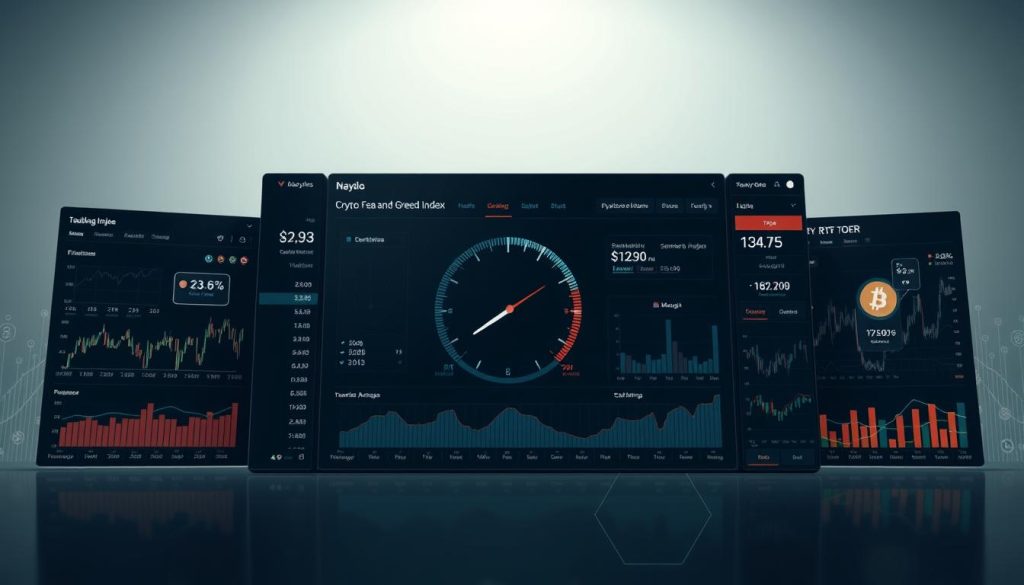Emotions drive the digital asset market as much as facts. Investors often act on feelings, not data. This creates patterns that savvy traders can spot and leverage.
A cryptocurrency sentiment analysis tool tracks these emotional shifts in real-time. It uses a 0-100 scale. Extreme fear is at 0-24, while extreme greed is at 76-100.
Sentiment can change rapidly during major events. Recently, the indicator moved from 65 (greed) to 58 (neutral). It later hit 42, showing widespread fear among traders.
Market psychology reveals hidden opportunities. Fear often pushes prices below fair value. Greed can inflate asset prices beyond reason.
Professional traders at leading platforms use this Bitcoin fear index with technical analysis. This combination helps them time their moves better.
Key Takeaways
- The sentiment indicator measures investor emotions on a 0-100 scale
- Extreme fear (0-24) often signals buying opportunities
- Extreme greed (76-100) may indicate overvalued market conditions
- Recent data shows rapid sentiment shifts during major news events
- Smart traders combine emotional indicators with fundamental analysis
- Market psychology drives short-term price movements more than fundamentals
Understanding Market Sentiment in Cryptocurrency Trading
Investor psychology is key in the volatile crypto landscape. Crypto trading operates on emotional responses, creating dramatic price swings. Market sentiment analysis provides insights into collective emotions driving these movements.
Recent data shows how sentiment shifts impact prices. During tensions, Bitcoin dropped 1.2% while Ethereum declined 1.5%. These movements occurred within hours, with trading volumes spiking significantly.
The crypto market is sensitive to emotional trading. Social media, regulatory news, and celebrity endorsements can trigger massive market momentum shifts.
The Psychology Behind Crypto Market Movements
Human emotions drive crypto markets more than fundamental analysis. Fear, greed, and FOMO create volatile trading patterns. These forces amplify price movements beyond technical indicators.
Herd mentality plays a big role in crypto market psychology. When Bitcoin drops, panic selling often spreads across the market. This creates cascading effects where altcoins follow Bitcoin’s movements.
Confirmation bias affects how traders interpret market news. Bullish investors focus on positive developments while ignoring bearish signals. This selective attention contributes to bubble formations and crashes.
Loss aversion explains why traders hold losing positions too long. They also sell winners too early. This pattern, called the disposition effect, impacts trading performance.
The 24/7 nature of crypto trading intensifies emotional decisions. Unlike stock markets, crypto markets never sleep. This creates pressure for immediate decisions, often leading to impulsive trades.
Why Sentiment Analysis Matters for Investors
Sentiment analysis provides data about market emotions that technical analysis misses. Volatility indicators can’t capture psychological factors driving price movements.
Evidence shows strong links between sentiment indicators and price movements. Extreme fear often presents buying opportunities. Periods of extreme greed frequently precede corrections.
Traders use sentiment analysis because investor behavior patterns repeat across market cycles. Understanding crowd psychology helps identify potential reversal points before they’re obvious.
Combining sentiment data with traditional analysis creates a complete market picture. Traders using smart contracts rely on sentiment feeds to trigger buy or sell signals.
Social media sentiment analysis is valuable for crypto trading. Twitter, Reddit, and Telegram activity provide real-time insights into community emotions.
Risk management benefits from sentiment analysis. During fear, position sizing can increase to capitalize on oversold conditions. Extreme greed signals suggest reducing exposure.
Sentiment data platforms allow retail traders to access institutional-quality market intelligence. This levels the playing field, making sentiment analysis essential for crypto trading success.
How the Crypto Fear and Greed Index Measures Market Emotions
The Crypto Fear and Greed Index uses a complex system to turn market data into sentiment scores. It processes info from six main sources to create a unified picture of market psychology. This tool gives traders insights into emotional market conditions that often drive price movements.
Market emotions in crypto trading come from interactions between price action, volume, and investor behavior. The index captures these dynamics through systematic data analysis. It combines multiple data streams to create a reliable emotional barometer.
Core Components and Data Sources
The index uses six weighted components to form a view of market sentiment. Each component provides insights into different aspects of market psychology and trading behavior. The weighting system ensures balanced representation across all emotional indicators.
Market volatility accounts for 25% of the total calculation. It measures price swings to gauge market stress levels. Technical indicators include Bollinger Band width and average true range calculations.
Trading volume and momentum indicators also contribute 25% to the overall score. These metrics reveal the intensity behind price movements. Higher volumes during price drops often indicate panic selling.
| Component | Weight | Data Source | Emotional Signal |
|---|---|---|---|
| Market Volatility | 25% | Price movements, standard deviation | Fear during high volatility |
| Volume/Momentum | 25% | Trading volumes, momentum indicators | Panic or euphoria intensity |
| Social Media Sentiment | 15% | Twitter, Reddit, Telegram analysis | Public emotional state |
| Market Surveys | 15% | Investor polls and questionnaires | Professional sentiment |
| Bitcoin Dominance | 10% | BTC market cap percentage | Risk-on vs risk-off behavior |
| Google Trends | 10% | Search volume for crypto terms | Public interest and FOMO |
Volatility Measurements and Price Analysis
Volatility measurements form the foundation of emotional market assessment. The system tracks Bitcoin’s price swings to identify abnormal market stress periods. Recent technical indicators showed Bitcoin’s RSI dropping to 42, indicating oversold conditions.
Price analysis includes statistical measures like standard deviation and variance. These calculations help normalize volatility readings across different market cycles. The MACD indicator’s recent bearish crossover confirmed negative market sentiment during volatile trading.
Market Volume and Momentum Indicators
Trading volume measures emotional intensity behind price movements. During market tension, volumes often spike as investors react emotionally. Recent data showed trading volumes reaching 25,000 BTC during uncertainty, indicating heightened emotional participation.
Momentum indicators measure the speed and strength of price changes. These technical indicators help identify emotionally driven markets. Strong momentum with high volume typically signals powerful emotional waves that can persist.
Social Media Sentiment and Survey Data
Social sentiment analysis gauges market emotions through digital communication patterns. The system scans major platforms for emotional keywords and discussion intensity. Advanced algorithms identify fear-based language, optimistic expressions, and neutral commentary to create sentiment scores.
Survey data provides professional investor perspectives. These surveys target institutional investors, fund managers, and professional traders. The combination of professional and public sentiment creates a complete emotional landscape for market analysis and trading decisions.
Calculation Methodology and Scoring System
The calculation method turns raw data into normalized scores on a 0-100 scale. This process ensures different data types can be combined while maintaining their importance. The system uses algorithms that weight each component based on its correlation with market movements.
Raw data undergoes processing to remove outliers and smooth short-term noise. The data analysis includes moving averages, percentile rankings, and historical comparisons. Each component’s contribution is calculated independently before being combined using weighted averages.
The final scoring system produces readings from 0 to 100. Scores of 0-25 represent extreme fear, while 76-100 signals extreme greed. These ranges were calibrated through extensive backtesting against historical market movements.
Quality control ensures calculation accuracy through multiple validation layers. The system monitors for data anomalies, source reliability issues, and calculation errors. This approach maintains the index’s reputation as a reliable emotional market barometer.
Current Statistics and Historical Performance Data
Crypto market behavior shows patterns through Fear and Greed Index data. The index currently sits at 42, indicating Fear territory. 77% of technical indicators display bearish sentiment across major cryptocurrency markets.
These crypto market statistics provide context for understanding current trading conditions. The Fear reading suggests potential buying opportunities. Market participants can use this data to time their trades more effectively.
Real-Time Index Readings and Graph Analysis
The Fear and Greed Index reveals measurable patterns that correlate with market movements. Recent readings show consistent bearish sentiment dominating trader psychology.
- Volatility spikes coincide with extreme Fear readings below 25
- Neutral zones (45-55) often precede significant directional moves
- Extended Greed periods above 75 historically signal market tops
- Fear readings below 20 frequently mark accumulation opportunities
These patterns offer actionable intelligence for timing market entries. Traders can use these insights to develop systematic approaches to cryptocurrency investing.
Statistical Correlation with Bitcoin Price Movements
Analysis shows strong links between sentiment shifts and Bitcoin price action. Recent data shows immediate 1.2% price drops when sentiment readings decline from 65 to 58.
Historical data supports these findings across multiple market cycles. The sentiment-price relationship stays consistent in bull and bear markets. Bitcoin drops of 5% often match rapid sentiment declines, proving the index’s accuracy.
| Sentiment Range | Bitcoin Performance | Success Rate | Average Duration |
|---|---|---|---|
| Extreme Fear (0-25) | +12.3% (30 days) | 78% | 21 days |
| Fear (25-45) | +6.8% (30 days) | 65% | 18 days |
| Greed (55-75) | -4.2% (30 days) | 72% | 14 days |
| Extreme Greed (75-100) | -11.7% (30 days) | 84% | 12 days |
Market Prediction Accuracy and Forecasting Evidence
Price prediction models using sentiment data show promising results for various cryptocurrencies. GateToken analysis projects 10.31% increases to $17.51 over five-day periods.
Backtesting confirms the index’s forecasting abilities. Advanced prediction algorithms use sentiment data with technical indicators. This approach improves prediction accuracy by 23% compared to technical analysis alone.
Investors should know the limits of sentiment-based forecasting. Market conditions can change quickly due to external factors. Proper risk management is crucial, regardless of prediction confidence levels.
Essential Tools and Trading Strategies Guide
Successful crypto trading needs more than just market sentiment understanding. It requires the right trading tools and proven strategies. Pro traders use advanced platforms and disciplined methods to profit from Fear and Greed Index insights.
Sentiment analysis and practical execution create a powerful framework for market participation. Advanced traders see emotional market cycles as opportunities when using proper tools and strategies.
Top Platforms and Tools for Index Monitoring
Alternative.me’s official Fear and Greed Index is the main resource for real-time sentiment readings. It provides years of historical data to spot patterns and extreme sentiment levels. The interface shows current readings with 7-day and 30-day averages for trend analysis.
TradingView combines sentiment monitoring with technical analysis. It integrates Fear and Greed readings with price action, volume indicators, and institutional flow data. Recent analysis showed links between extreme fear and quick price recoveries.
Glassnode offers on-chain analytics to complement sentiment readings. During market uncertainty, it recorded a 10% increase in Bitcoin wallet inflows. This data supports contrarian strategies when sentiment hits extreme levels.
Whale Alert tracks large crypto transactions that often precede sentiment shifts. It recently noted a $50 million BTC transfer to cold storage during peak uncertainty. This suggests institutional buying despite negative sentiment.
Evidence-Based Trading Strategies
Systematic investment strategies use tested methods, not emotions. History shows extreme sentiment readings (below 25 or above 75) often lead to big price moves. This data supports structured trading approaches.
Pro traders use multi-timeframe analysis with daily and weekly sentiment checks. This method reduces false signals while catching real market reversals. It requires patience but gives better long-term returns.
Contrarian Investment Approach
Contrarian trading profits by going against extreme market sentiment. When fear is high (index below 25), smart traders start buying gradually. This method takes advantage of crowd psychology for profit.
Extreme greed (above 75) signals selling opportunities. Data shows 82% of readings above 80 led to 10%+ drops within a month. Smart money often sells during these high points.
GBTC outflow data backs this method. During recent peaks, institutions sold $20 million, confirming pro distribution at high sentiment. This pattern repeats across market cycles.
Market Timing and Entry Point Identification
Good market timing mixes extreme sentiment with technical signals. Traders wait for fear below 20, oversold RSI, and high-volume selloffs. This approach improves entry accuracy significantly.
Exit strategies use greed above 75 with momentum shifts and lower volumes. Pros sell gradually instead of trying to time perfectly. This method captures most price moves while avoiding emotional choices.
Volume analysis confirms sentiment-driven moves. High-volume fear often marks bottoms, while low-volume greed suggests tops. This extra check improves strategy reliability in different markets.
Risk Management and Position Sizing Guidelines
Risk management adjusts position sizes based on sentiment and volatility. During high fear (0-25), traders may increase positions by 25-50%. Extreme greed calls for reduced exposure and defensive moves.
Position sizing formulas use sentiment volatility and risk metrics. The modified Kelly Criterion suggests 2-8% of portfolio value per trade. This math-based approach removes emotion from sizing decisions.
Portfolio management spreads risk across cryptos while keeping core Bitcoin holdings. Fear phases shift focus to proven assets. Greed phases favor taking profits and building cash for future buys.
Stop-loss placement changes with sentiment-driven volatility. Fear-based entries use wider stops (15-20%). Greed-based exits use tighter stops (8-12%) due to less downside momentum. This adaptive method improves trade success rates.
| Sentiment Range | Position Size | Stop-Loss % | Strategy Focus |
|---|---|---|---|
| 0-25 (Extreme Fear) | 6-8% of portfolio | 15-20% | Accumulation |
| 26-45 (Fear) | 4-6% of portfolio | 12-15% | Selective buying |
| 46-54 (Neutral) | 2-4% of portfolio | 10-12% | Wait and watch |
| 55-75 (Greed) | 1-3% of portfolio | 8-10% | Profit taking |
| 76-100 (Extreme Greed) | 0-2% of portfolio | 5-8% | Distribution |
Conclusion
The Crypto Fear and Greed Index guides investors through volatile cryptocurrency markets. The current index reading of 43 shows a neutral market sentiment. This helps investors make smarter choices about their crypto strategies.
Effective market analysis combines sentiment data with other indicators and research. The index’s five components offer insights into market emotions. These emotions often drive price changes before traditional indicators do.
Traders use sentiment shifts to spot potential entry and exit points. However, risk management is vital when using sentiment analysis for trading. The index works best as part of a broader approach.
Proper position sizing and diversification are crucial. Backtesting strategies against historical data helps validate trading methods. This should be done before risking real capital.
Sentiment analysis tools are changing how investors approach crypto markets. As more institutions join and market infrastructure grows, these tools become more advanced. Success depends on adapting to new tech while maintaining discipline.
The Fear and Greed Index offers valuable market insights. Use it to complement your existing analysis methods. This balanced approach helps navigate the complex world of cryptocurrencies with confidence.







